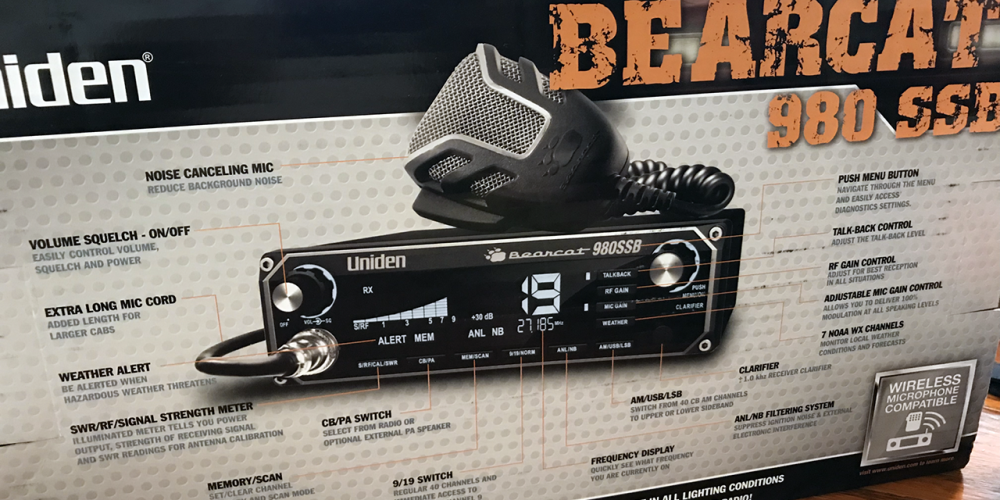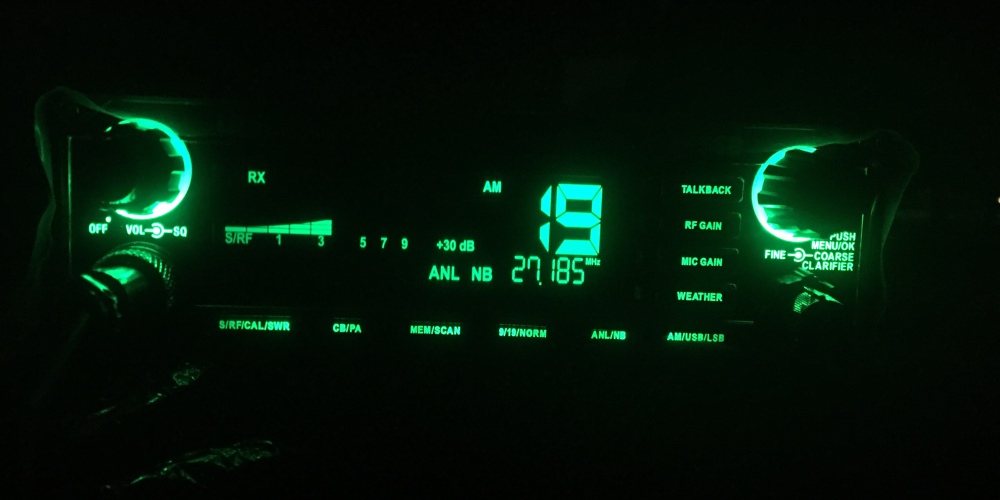The new CB, along with my never-used external speaker, are mounted to the Tuffy overhead console. Next, it’s time to drop the top and lower the sound bar for install.


The new CB, along with my never-used external speaker, are mounted to the Tuffy overhead console. Next, it’s time to drop the top and lower the sound bar for install.

Those who’ve followed this site will have seen that my year-old CB radio recently died a sudden, unexpected death. I’m a firm believer in the notion that anytime a part or system fails, it’s a valuable process to reevaluate your needs and the available solutions, rather than rushing to replace whatever was lost.
So, I’ve been doing a good bit of thinking and researching, answering some questions for myself:
While it’s undeniable off-road enthusiasts in many parts of the country are moving away from AM CB in favor of GMRS or even HAM radio, here in the Texas Panhandle, CB remains the go-to for trail communications. I’ll definitely want a new CB, but I do plan to later add a GMRS unit as a second radio for out-of-area trips.
The Uniden Bearcat 980 SSB I’m replacing is the successor to a Cobra 75 WX ST, that company’s all-in-one unit that puts all controls and display in the radio handset. While the Cobra unquestioningly was more convenient, I was never satisfied with that radio’s performance. More than that, I’ve read numerous reports suggesting all-in-one units like the Cobra tend to have power outputs far below the legal four-watt maximum. As someone who’ll use this radio for more than just trail comms, I want a stock radio that will give me the maximum legal output. Further, I’ve been very happy with the Tuffy Overhead Storage Console. I have the console mount. There’s no benefit to a change here.
A CB-only radio would cost a little less than one with sideband, but the difference between the CB-only Bearcat 880 and the SSB-equipped 980 is only $13 via Amazon. That’s a small price to pay for the opportunity I’ve had to speak with radio users from Wisconsin, Utah and more using stock factory power output.
This boils down to two things: First, I’ve been very happy with my existing 980 SSB. The only thing I’d change on the radio is to make the RF gain function a tunable knob rather than a stepped button. Second, sideband-equipped radios are hard to find. The only new option of which I’m aware is the President McKinley, which has an aesthetic for which I don’t care and a price tag well north of the Uniden.
In short, I’m happy with the radio I had. When I purchase a new radio, it’ll be another Uniden Bearcat 980. I will, however, make a couple of changes: In recent months, my 980’s speaker had begun to exhibit some minor audio overload/vibration when the volume was set too high. So, I’ll be installing the Uniden external speaker that’s sat in the box in my garage for a few years now.
Finally, I can’t deny that while I’ve enjoyed excellent performance from the Wilson Silver Load antennas I’ve employed, I’ve been through five in the last year. That accounts for $150 spent on antennas in 12 months’ time! A broken first antenna prompted me to add a spring to my mount. The spring, though, allowed enough movement that the antenna constantly rubbed against my tire carrier, removing the plastic covering and creating the potential for a shorted antenna and high SWR. So, look for some kind of change in my antenna setup when a new radio enters the picture. That may mean a new mount or mount location, a new antenna type — who knows? — I’ll continue planning on that one and hope to have Smokey back on the airwaves soon.

I won’t have time to permanently install my new Uniden Bearcat 980 SSB until after Labor Day, but I couldn’t let that stop me from doing a quick temporary install to give it a try.
Here’s an initial report:
Watch for more, coming soon!

Haven’t I been here already?
For the second time in as many months, a delivery service left a new CB on my doorstep today.
When I decided to utilize birthday gifts to replace my aging and cracking Cobra 75 WX ST all-in-one radio, I at first set my sights on the Uniden Bearcat 980 SSB. I recall my father tinkering with AM sideband while I was growing up, and I’d recently been inspired to pick back up on the amateur radio hobby I’d left behind after college. But, I couldn’t decide how to fit a full-size radio in a two-door Jeep JK, so I instead turned to Uniden’s allegedly bulletproof Pro line. My first CB was a Pro 510 XL, and it provided more than 20 years of trouble-free use.
The new Uniden, however, showed me a lot may have changed in 20 years. Gone were the crisp channel changes, as the new 520 XL I picked up would change frequencies unintentionally with the slightest twist of the dial. The real issue, though, came one night while I sat in my driveway trying to raise a contact.
At the alarming smell of smoke, I turned on the interior light and scanned for the telltale white indicator. I didn’t find any sign of trouble there or under the hood, though, and called it a night. The next day, I discovered my 520 no longer received or transmitted at anything resembling normal range.
Some experimentation revealed I couldn’t send or receive past about a half-mile, and the visual signal indicators dropped to zero anytime I installed a microphone. So, the three-week-old radio was quickly shipped back to the online retailer from whence it came.
Presented with this second chance, I decided to go with the unit I’d wanted in the first place, the feature-packed 980 SSB. It’ll be a little while before I’m able to make time to install this radio, but stay tuned for my initial impressions and installation in the not too distant future.

I recently shared I’d decided to make addressing my CB’s unacceptable SWR measurements, which have been well north of five for years, a summer Jeep project.
My first suspect was my two-foot antenna, which cleared my roofline by an inch, at most. I’d already used a multimeter to verify continuity between grounds and rule out opens or shorts in the coaxial cable So, my first step was to procure a longer antenna for testing.
 My plan had been to pick up a three-foot top-loaded fiberglass antenna with a quick-tune adjustable tip. Perusing the local retailers, though, offered few options. I found a few original Firestiks in that length, but it was the Firestik II that has an adjustable tip. And, yielding to aesthetics for a moment, I hate that company’s red tip covers, which don’t go with Smokey’s black-and-silver color scheme. What I did find was a four-foot Wilson Silver Load that, aside from its length, had the features I wanted.
My plan had been to pick up a three-foot top-loaded fiberglass antenna with a quick-tune adjustable tip. Perusing the local retailers, though, offered few options. I found a few original Firestiks in that length, but it was the Firestik II that has an adjustable tip. And, yielding to aesthetics for a moment, I hate that company’s red tip covers, which don’t go with Smokey’s black-and-silver color scheme. What I did find was a four-foot Wilson Silver Load that, aside from its length, had the features I wanted.
Mounting the new antenna, I performed a quick-and-dirty SWR test in my driveway. (It’s always preferable to be well clear of any buildings or power lines for this testing. My final tests were conducted out of town in wide-open spaces.) Immediately, it was evident the antenna was a huge portion of my issue, as even next to my house, the readings fell within the acceptable range under two. (The near-impossible goal is to have readings at both ends of the frequency spectrum at an identical 1:1. Anything under 2:1, or just “2,” is acceptable, and readings above three can damage your radio.)
With that issue effectively addressed, I discovered that my spring, which had tested fine by itself, actually raised my SWRs. Erring on the side of caution, I picked up replacements for my spring and antenna-mount stud, both of which I’d originally picked up in college.
After a bit of adjusting, I have my readings now sitting as follows:
While there’s still a small bit of room for improvement, I’m going to leave these settings for now, as I’ll eventually add a quick disconnect for the new antenna, which will necessitate its own round of adjustment. I’ve also temporarily mounted the external speaker that’s sat in my garage for years. It’s a big improvement over the built-in two-watt Cobra speaker.
Finally, I learned in this process that my intent to replace my radio itself — the mic cable sheath has been cracking and flaking off the four-year-old Cobra for months — should probably come sooner rather than later. Paying closer attention to my radio and SWR meter than I had in the past revealed my radio intermittently puts out two, rather than the full four, watts of power.
Watch for an update on that soon.